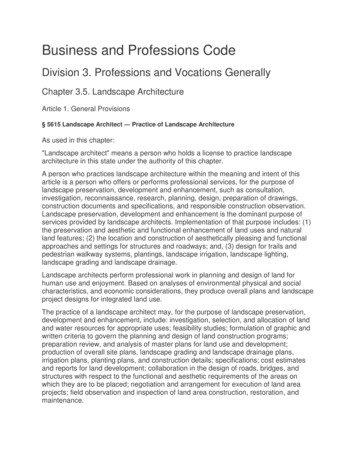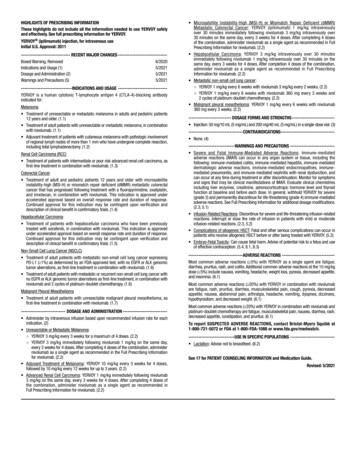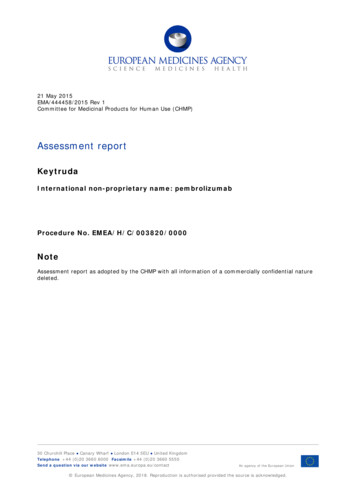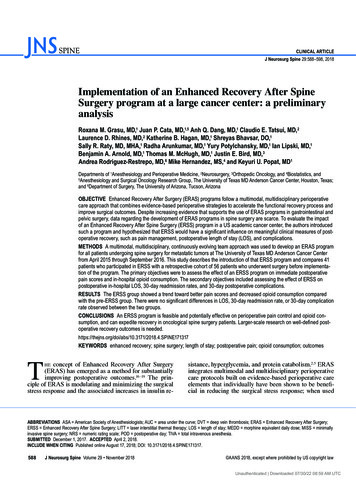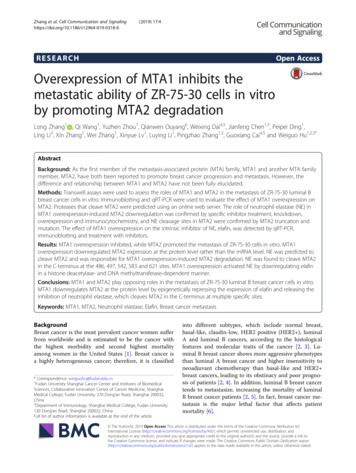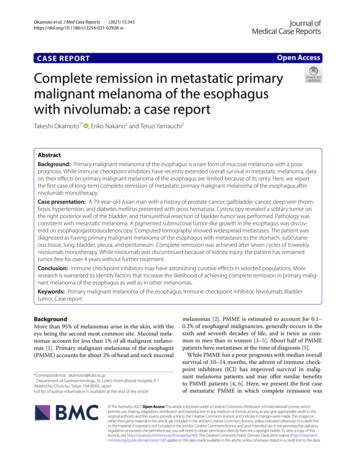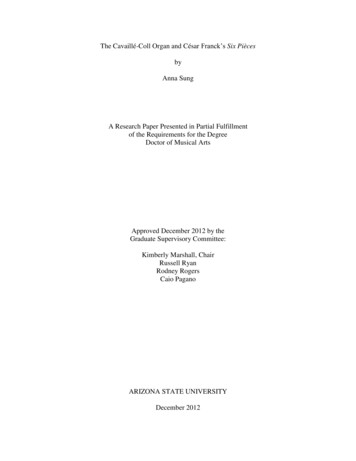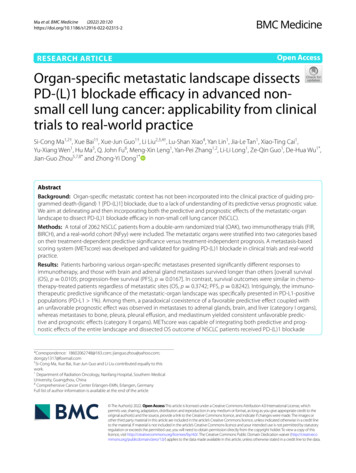
Transcription
(2022) 20:120Ma et al. BMC RESEARCH ARTICLEOpen AccessOrgan-specific metastatic landscape dissectsPD-(L)1 blockade efficacy in advanced nonsmall cell lung cancer: applicability from clinicaltrials to real-world practiceSi‑Cong Ma1,2†, Xue Bai1†, Xue‑Jun Guo1†, Li Liu2,3,4†, Lu‑Shan Xiao4, Yan Lin1, Jia‑Le Tan1, Xiao‑Ting Cai1,Yu‑Xiang Wen1, Hu Ma5, Q. John Fu6, Meng‑Xin Leng1, Yan‑Pei Zhang1,2, Li‑Li Long1, Ze‑Qin Guo1, De‑Hua Wu1*,Jian‑Guo Zhou5,7,8* and Zhong‑Yi Dong1*AbstractBackground: Organ-specific metastatic context has not been incorporated into the clinical practice of guiding pro‑grammed death-(ligand) 1 [PD-(L)1] blockade, due to a lack of understanding of its predictive versus prognostic value.We aim at delineating and then incorporating both the predictive and prognostic effects of the metastatic-organlandscape to dissect PD-(L)1 blockade efficacy in non-small cell lung cancer (NSCLC).Methods: A total of 2062 NSCLC patients from a double-arm randomized trial (OAK), two immunotherapy trials (FIR,BIRCH), and a real-world cohort (NFyy) were included. The metastatic organs were stratified into two categories basedon their treatment-dependent predictive significance versus treatment-independent prognosis. A metastasis-basedscoring system (METscore) was developed and validated for guiding PD-(L)1 blockade in clinical trials and real-worldpractice.Results: Patients harboring various organ-specific metastases presented significantly different responses toimmunotherapy, and those with brain and adrenal gland metastases survived longer than others [overall survival(OS), p 0.0105; progression-free survival (PFS), p 0.0167]. In contrast, survival outcomes were similar in chemo‑therapy-treated patients regardless of metastatic sites (OS, p 0.3742; PFS, p 0.8242). Intriguingly, the immuno‑therapeutic predictive significance of the metastatic-organ landscape was specifically presented in PD-L1-positivepopulations (PD-L1 1%). Among them, a paradoxical coexistence of a favorable predictive effect coupled withan unfavorable prognostic effect was observed in metastases to adrenal glands, brain, and liver (category I organs),whereas metastases to bone, pleura, pleural effusion, and mediastinum yielded consistent unfavorable predic‑tive and prognostic effects (category II organs). METscore was capable of integrating both predictive and prog‑nostic effects of the entire landscape and dissected OS outcome of NSCLC patients received PD-(L)1 blockade*Correspondence: 18602062748@163.com; -Cong Ma, Xue Bai, Xue-Jun Guo and Li Liu contributed equally to thiswork.1Department of Radiation Oncology, Nanfang Hospital, Southern MedicalUniversity, Guangzhou, China8Comprehensive Cancer Center Erlangen-EMN, Erlangen, GermanyFull list of author information is available at the end of the article The Author(s) 2022. Open Access This article is licensed under a Creative Commons Attribution 4.0 International License, whichpermits use, sharing, adaptation, distribution and reproduction in any medium or format, as long as you give appropriate credit to theoriginal author(s) and the source, provide a link to the Creative Commons licence, and indicate if changes were made. The images orother third party material in this article are included in the article’s Creative Commons licence, unless indicated otherwise in a credit lineto the material. If material is not included in the article’s Creative Commons licence and your intended use is not permitted by statutoryregulation or exceeds the permitted use, you will need to obtain permission directly from the copyright holder. To view a copy of thislicence, visit http:// creat iveco mmons. org/ licen ses/ by/4. 0/. The Creative Commons Public Domain Dedication waiver (http:// creat iveco mmons. org/ publi cdoma in/ zero/1. 0/) applies to the data made available in this article, unless otherwise stated in a credit line to the data.
Ma et al. BMC Medicine(2022) 20:120Page 2 of 12(p 0.0001) but not chemotherapy (p 0.0805) in the OAK training cohort. Meanwhile, general performance ofMETscore was first validated in FIR (p 0.0350) and BIRCH (p 0.0001), and then in the real-world NFyy cohort (p 0.0181). Notably, METscore was also applicable to patients received PD-(L)1 blockade as first-line treatment both inthe clinical trials (OS, p 0.0087; PFS, p 0.0290) and in the real-world practice (OS, p 0.0182; PFS, p 0.0045).Conclusions: Organ-specific metastatic landscape served as a potential predictor of immunotherapy, and METscoremight enable noninvasive forecast of PD-(L)1 blockade efficacy using baseline radiologic assessments in advancedNSCLC.Keywords: Metastatic-organ landscape, Non-small cell lung cancer, Immune checkpoint inhibitor, Programmeddeath-(ligand) 1BackgroundImmune checkpoint inhibitors (ICIs), principally represented by monoclonal antibodies targeting programmeddeath-1 (PD-1) or programmed death-ligand 1 (PD-L1),have transformed the therapeutic paradigm and becomethe pillar regimens for advanced or metastatic non-smallcell lung cancer (NSCLC) [1, 2]. Despite the relative success of immunotherapy over chemotherapy witnessed inthe past decade, PD-(L)1 blockade was far from perfect toinduce durable immune responses for every patient fromthe total unselected NSCLC population, even within thePD-L1-positive stratum, calling for an exigent need ofreliable immunotherapeutic predictors to promote precision medicine.Effectiveness of ICI therapy has been associated withthe biological peculiarity of tumor microenvironmentdiffered by anatomical locations [3]. By a logical extension of this notion, it is envisioned that the heterogeneityof immunotherapeutic efficacy in the metastatic settingmight depend on the interplay of the overall antitumorimmunity with the local metastatic-organ microenvironment [4]. Preliminary evidences have demonstratedthe negative correlation between survival prospectsand distant metastases (e.g., liver metastasis) in NSCLCtreated with ICIs [5, 6]. Nevertheless, these studies wereconducted in a single-arm setting of ICIs, which lackeda controlled arm of conventional treatment for comparison, resulting in an ignorance of the predictive versusprognostic effect [7]. Besides, the therapeutic impact ofeach metastatic organ was previously investigated in isolation, but comprehensive analysis that looks at the bigpicture and incorporates the entire metastatic landscapeis still lacking; as tumors could spread to several organsconcurrently for patients with advanced stage cancers,outcome studies that focused on single organ metastasispresented limited clinical significance.On this ground, we assumed that only by integrativedelineation of the whole metastatic-organ landscape fromboth perspectives of prognostic and predictive effectscould we systematically assess the impact of organ metastases on ICI therapy. For this purpose, we discriminatedthe predictive versus prognostic effect of each metastaticorgan within a double-arm randomized trial cohort,and further proposed a metastasis-based scoring system(METscore), which incorporated both prognostic andpredictive effects of the metastatic-organ landscape, toforecast survival outcomes of advanced NSCLC patientstreated with ICI therapy in clinical-trial and real-wordcohorts.MethodsPopulationWe conducted a retrospective study of individualparticipant data from three clinical trials (OAK:NCT02008227, N 850; FIR: NCT01846416, N 136;BIRCH: NCT02031458, N 667) [8–10] and a realword cohort from Nanfang Hospital, Southern MedicalUniversity (NFyy: N 409), giving a total sample size of2062 advanced-stage NSCLC patients. OAK was a randomized phase III trial comparing atezolizumab versusdocetaxel in previously treated NSCLC patients [11, 12].FIR and BIRCH were both phase II atezolizumab trialsin chemotherapy-naïve or previously treated PD-L1-selected NSCLC patients [13, 14]. Detailed informationabout these three clinical trials has been described in thecorresponding studies [11, 13, 14]. Deidentified individual-participant data of the clinical trials were accessedaccording to Roche’s policy and process for clinical studydata sharing. The NFyy cohort included patients diagnosed with metastatic NSCLC who were treated with atleast one dose of ICIs as first-line or subsequent regimen,which was collected after the approval of the InstitutionalEthical Review Boards of Nanfang Hospital. The clinicalcharacteristics of the NFyy cohort are summarized inAdditional file 1: Table S1.Baseline PD-L1 status of the three trial cohorts wasprospectively tested using the SP142 antibody, scoredas a percentage of tumor cells (TC0: 1%; TC1: 1%but 5%; TC2: 5% but 50%; TC3: 50%) or tumorinfiltrating immune cells (IC0: 1%; IC1: 1% but 5%;IC2: 5% but 10%; IC3: 10%) with PD-L1 staining[11, 13, 14]. PD-L1 expression of the real-world NFyy
Ma et al. BMC Medicine(2022) 20:120cohort was tested before treatment using the 22C3 antibody and calculated as a tumor proportion score (TPS).Patients with PD-L1 TC/IC or TPS of at least 1% wereconsidered positive for the respective immunohistochemistry assays. Among these cohorts, 465 patients inOAK and 367 in NFyy were tested as PD-L1 positive,while patients in PD-L1-selected FIR and BIRCH trialswere all confirmed positive at enrollment.Study designThe workflow of the study was illustrated in Fig. 1. Wefirst took advantage of the OAK trial as it endorsedtwo arms of patients (immunotherapy versus chemotherapy) so that we were able to delineate the predictiveversus prognostic effect of distant metastases. Then, ametastasis-based scoring system, termed METscore,was developed to incorporate both the immunotherapyspecific predictive effect and the treatment-independentprognostic effect of the whole metastatic-organ landscape, thereby forecasting clinical outcomes of ICItherapy. The generalization performance of METscorewas tested in single-arm FIR and BIRCH trials and thereal-world NFyy cohort. Moreover, the discriminationability was validated in the first-line ICI setting. Overallsurvival (OS) was defined as the primary endpoint, andPage 3 of 12progression-free survival (PFS) was the co-primary endpoint as an addition to OS for first-line cohorts.Prognostic and predictive effects of metastatic‑organlandscapePretreatment statuses of common distant metastaticorgans of NSCLC were included for analysis; those withincidence of 5% in OAK were not examined. Thus, themetastatic-organ landscape comprised adrenal glands,brain, liver, bone, pleura, pleural effusion, and mediastinum in the present study. These metastatic organs weredivided into two categories based on their predictivevalue for ICI therapy. Accordingly, category I metastaticorgans were defined as those with survival benefits ofimmunotherapy over chemotherapy, while others weredefined as category II.Multivariate Cox proportional hazard regression wasperformed to delineate the predictive versus prognosticeffect of each metastatic organ via the inclusion of metastatic statuses of organs, treatment arm, and treatmentby-organ interaction terms using the randomized OAKdata (Additional file 2: Table S2). The model coefficientswere scaled from 5 to 5 and rounded to the nearest integers to facilitate clinical use [15, 16]. The scaledpoints corresponding to the metastatic statuses of organsFig. 1 Flowchart showing the design of the study. The double-arm OAK trial (atezolizumab versus docetaxel) was used as a discovery cohort toidentify the prognostic and predictive effects of metastatic organs. A metastasis-based scoring system, termed METscore, was developed to forecastsurvival prospects of ICI therapy in the PD-L1-positvive population, and was further validated in PD-L1-selected atezolizumab trials (FIR and BIRCH)and a real-word ICI cohort. Abbreviations: NSCLC, non-small cell lung cancer; ICI, immune checkpoint inhibitor; PD-L1, programmed death-ligand 1;TC, tumor cell, IC: immune cell
Ma et al. BMC Medicine(2022) 20:120Page 4 of 12Fig. 2 Metastatic-organ landscape as a determinant of survival outcomes specific to immune checkpoint-based therapy. Kaplan-Meier curvescomparing overall survival among various metastatic organs in A atezolizumab- and B docetaxel-treated populations. C Pairwise comparisonsof overall survival in the atezolizumab- (lower triangle) and docetaxel-treated (upper triangle) populations. Kaplan-Meier curves comparingprogression-free survival per metastatic organs in C atezolizumab- and D docetaxel-treated populations. E Pairwise comparisons of progression-freesurvival in the atezolizumab- (lower triangle) and docetaxel-treated (upper triangle) populations. Data in each cell of C and F represents hazard ratio(95% interval confidence) for the pairwise comparison of row-defining organ versus column-defining organ. Significant results are in bold red font.Abbreviations: Met, metastasis; PEFF, pleural effusion; Media, mediastinumdelineated the treatment-independent prognostic effects,while those corresponding to treatment-by-organ interactions delineated the immunotherapy-specific predictive effects (Additional file 3: Table S3). The METscore inforecasting outcomes of ICI therapy was then set up toincorporate the prognostic and predictive effects of eachmetastatic organ by calculating the total points.Statistical analysisKaplan-Meier method and log-rank test were used forcomparing survival outcomes among groups, with hazard ratio (HR) and 95% confidence interval (CI) reported.Survival analyses were conducted in GraphPad Prism(version 8.0.1) or R (version 3.6.1) with R packages “survival” and “survminer.” Multivariate Cox proportionalhazard regression was implemented using R package“survival.” The optimum cut-point for METscore wasdetermined by maximally selected rank statistics usingthe R package “maxstat” with a minimal proportion of20% in each group by setting the parameter “minprop” as0.2. All statistical tests were two sided, and P 0.05 wasdeemed statistically significant.ResultsSpecific predictive effect of metastatic‑organ landscapefor ICI therapyTo delineate the immunotherapeutic predictive effectof organ metastases, we explored the impact of metastatic-organ landscape on survival outcomes in theatezolizumab arm and the docetaxel arm from OAKrespectively. In terms of OS, survival prospects were significantly different among patients with various metastatic organs in the atezolizumab-treated population (P 0.0105; Fig. 2A). Nevertheless, OS was generally similarin the docetaxel-treated population regardless of metastatic organs (P 0.3742; Fig. 2B). Pairwise comparisons among metastatic organs in the atezolizumab armshowed that adrenal gland metastasis and brain metastasis yielded the best long-term survival benefits, with significantly longer OS compared with metastases to otherorgans, including liver, bone, and pleural effusion (thelower triangle in Fig. 2C). With regard to the docetaxelarm, however, no significant difference of OS existedbetween any pair of metastatic organs (the upper trianglein Fig. 2C).
Ma et al. BMC Medicine(2022) 20:120Page 5 of 12Fig. 3 Predictive significance of metastatic-organ landscape for efficacy with immunotherapy versus chemotherapy in a PD-L1-dependent fashion.Forest plots showing overall survival (OS) benefits of atezolizumab versus docetaxel per organ metastatic category in A the total, B PD-L1-positive(TC/IC 1%), and C PD-L1-negative (TC/IC 1%) populations from OAK trial. Two categories of metastatic organs were identified based on OSbenefits of atezolizumab versus docetaxel in the PD-L1-positive population, and metastases to category I organ (adrenal glands, brain, and liver)presented significantly better OS results in atezolizumab arm versus docetaxel arm, while metastases to category II organ (bone, pleura, pleuraleffusion, and mediastinum) derived no benefit from atezolizumab over docetaxel. Abbreviations: Atezo, atezolizumab; Doce, docetaxel; CI,confidence interval; PD-L1, programmed death-ligand 1; TC, tumor cell; IC, immune cellConsistent findings were observed in terms of PFS,where significant survival difference was seen amongatezolizumab-treated patients with various metastaticorgans (P 0.0167; Fig. 2D) but not in docetaxel-treatedpopulations (P 0.8242; Fig. 2E). In agreement with this,there only existed significant differences of PFS in pairwise comparisons in the atezolizumab arm (the lower triangle in Fig. 2F) but not in the docetaxel arm (the uppertriangle in Fig. 2F).Metastatic‑organ landscape as a predictor in a PD‑L1dependent mannerUpon comparing the efficacy following treatment withimmunotherapy and chemotherapy, we found an identifiable association between the metastatic-organ landscape and the clinical benefits of atezolizumab versusdocetaxel in the total population from OAK (Fig. 3A).On account of the clinical practice of immunotherapyin patients who were PD-L1 positive ( 1%), we investigated the predictive effect (immunotherapy versuschemotherapy) of the metastatic-organ landscape stratified by PD-L1 status. Intriguingly, the predictive effectwas observed exclusively in the PD-L1-positive population (TC/IC 1%; Fig. 3B) rather than in the PDL1-negative population (TC/IC 1%; Fig. 3C).In general, the predictive significance varied acrossmetastatic organs at different degrees or even conversely within the PD-L1-positive population, whichdefined two organ categories (Fig. 3). For category Iorgans, OS benefits of atezolizumab versus docetaxelwere found in patients whose tumors metastasizedto adrenal glands (HR 0.42, 95% CI 0.25–0.70), brain(HR 0.41, 95% CI 0.19–0.88), and liver (HR 0.57, 95%CI 0.36–0.89) (Fig. 3B). On the contrary, for bone,pleural, pleural effusion, and mediastinum, patientsharboring metastasis to any of these category IIorgans did not benefit from atezolizumab relative todocetaxel (Fig. 3B). Synergistic predictive effect wasfound among the category I organ metastases (adrenal glands, brain, and liver) within the PD-L1-positive population (Additional file 4: Fig. S1A-F), wherethe OS benefits of atezolizumab versus docetaxel inpatients with metastases to double category I organs(HR 0.32, 95% CI 0.14-0.76, P 0.0013; Additional
Ma et al. BMC Medicine(2022) 20:120file 4: Fig. S1C) were even more pronounced in comparison to those with metastasis to a single categoryI organ (HR 0.59, 95% CI 0.41-0.85, P 0.0048; Additional file 4: Fig. S1B).We also examined the predictive versus prognostic effect of the metastatic statuses of category I organs(Additional file 5: Fig. S2A-D). Remarkably within thePD-L1-positvie population, the presence of the categoryI organ metastases was associated with decreased OSin the docetaxel arm (P 0.0001; Additional file 5: Fig.S2B), indicative of the inherent unfavorable prognosticeffect of metastases. In contrast, OS was not influencedby the metastatic number of the category I organs inthe atezolizumab arm (P 0.5978; Additional file 5: Fig.S2A), suggesting that the unfavorable prognostic effectwas alleviated by the favorable predictive effect specificto immunotherapy. Conversely, the inherent unfavorable prognostic effect of metastases became discerniblein PD-L1-negative patients treated with atezolizumab,since the immunotherapeutic predictive effect was absentin this population; consequently, we observed a negativecorrelation between OS and the number of the category Iorgan metastases (P 0.0005; Additional file 5: Fig. S2C).Incorporating metastatic‑organ landscape to forecast ICItherapyThe synergistic value of different metastatic organsinspired us to incorporate the whole landscape for comprehensive assessment. Having identified metastaticorgan landscape as a determinant of both inherentprognosis and immunotherapeutic benefit, we believedthat only through incorporating both the treatmentindependent prognostic effect and the immunotherapyspecific predictive effect of the whole metastatic-organlandscape could we truly reflect its impact on ICI therapy.To this end, we proposed a metastasis-based scoring system (METscore) to forecast survival outcomes ofadvanced-stage NSCLC patients treated with ICI agentsusing the PD-L1-positive OAK cohort, since the therapeutic impact was particularly witnessed in this stratum(Fig. 4A). On this basis, given a metastatic profile of acertain patient obtained from pretreatment radiologicassessments, two scaled points could be assigned to eachmetastatic organ, one of which delineated the prognostic effect and the other delineated the predictive effect.The total points of prognostic and predictive effects ofthe whole metastatic-organ landscape constituted theMETscore in forecasting the survival benefits followingICI therapy.A range of putative cut-points (0 5) for METscore wasassessed in the atezolizumab population (Fig. 4B). Therewas a general pattern of prolonged OS in patients withlower METscore relative to those with higher METscore,Page 6 of 12and an enlarged OS difference could be expected if morestringent cut-points (4 and 5) were selected (Fig. 4B). Forpractical application, the optimal cut-point of METscore,corresponding to 3 achieved by the maximally selectedrank statistics, was determined by weighing the survival benefits against the minimal proportion of eachgroup. And patients were classified into METscore-High(METscore 3) and -Low (METscore 3) categoriesaccordingly. Thereupon, the METscore system and thethreshold were eventually locked for performance evaluation throughout the study. The system has been translated into a web-based tool that is freely available to thepublic (Additional file 6: Fig. S3).METscore enables identification of therapeutic benefitfrom checkpoint blockadeWe first evaluated the discrimination performance ofMETscore in the PD-L1-positive OAK cohort. Patientswith METscore-Low obtained significantly longer OSthan METscore-High counterparts in the atezolizumabtreated population (HR 0.48, 95% CI 0.32–0.72, P 0.0001;Fig. 5A). By contrast, there was no significant difference interms of OS between METscore-Low and -High groupsin the docetaxel-treated population (HR 0.73, 95% CI0.49–1.07, P 0.0805; Fig. 5B). Concurrently, upon directcomparison of survival prospects following treatmentwith immunotherapy and chemotherapy, OS was demonstrated to favor atezolizumab as compared to docetaxelwithin the METscore-Low group (HR 0.64, 95% CI 0.49–0.84, P 0.0011; Additional file 7: Fig. S4A), whereas itwas generally similar between the two arms within theMETscore-High group (HR 0.98, 95% CI 0.64–1.48, P 0.9121; Additional file 7: Fig. S4B). These results indicatedthat METscore enabled noninvasive identification of beneficiaries of ICI therapy, i.e., the METscore-Low patients.Generalization of METscore in external clinical‑trialand real‑world cohortsThe METscore-based system was then externally validated in PD-L1-selected clinical-trial and real-worldcohorts. In FIR, the use of METscore allowed stratification of patients into METscore-High and -Low groupswith significant difference of OS (HR 0.57, 95% CI 0.33–0.97, P 0.0350; Fig. 5C). In BIRCH, OS rates consistently favored METscore-Low over METscore-High (HR0.53, 95% CI 0.40–0.71, P 0.0001; Fig. 5). On top of that,the generalization performance of METscore was confirmed in NFyy, where patients with METscore-Low hadprolonged OS than those with METscore-High (HR 0.60,95% CI 0.39–0.92, P 0.0181; Fig. 5E).Considering that ICI has become the first-line treatmentof advanced NSCLC [17], we evaluated the discrimination performance of METscore specifically in the first-line
Ma et al. BMC Medicine(2022) 20:120Page 7 of 12Fig. 4 A metastasis-based scoring system (METscore) incorporating prognostic and predictive effects for ICI prediction in the PD-L1-positivepopulation. A Nomogram illustrating scaled points as proxy for prognostic and predictive effects of metastatic organs, and the total points asMETscore for the prediction of overall survival of PD-L1-positvive patients following ICI therapy. B Putative cut-points (0 5) of METscore to stratifyPD-L1-positive patients into -High and -Low groups with significantly different OS in the atezolizumab-treated population from OAK. Abbreviations:Met, metastasis; Non, non-metastasis; CI, confidence interval; OS, overall survival; ICI, immune checkpoint inhibitor; PD-L1, programmed celldeath-ligand 1setting. It is noteworthy that survival prospects were significantly longer for METscore-Low patients referencedto METscore-High patients in the first-line FIR/BIRCHcohort in terms of both OS (HR 0.44, 95% CI 0.23–0.83,P 0.0087; Fig. 6A) and PFS (HR 0.56, 95% CI 0.32–0.95,P 0.0290; Fig. 6B). The significant survival advantage ofMETscore-Low over METscore-High groups were replicated in the first-line NFyy cohort according to OS (HR0.51, 95% CI 0.29–0.90, P 0.0182; Fig. 6C) and PFS (HR0.45, 95% CI 0.25–0.80, P 0.0045; Fig. 6D).DiscussionUnderstanding organ-specific tumor immune contexthas been one of the top ten challenges in cancer immunotherapy [4]. However, even in an era of precisionmedicine where regimens are increasingly informed bymulti-omic data, the role of metastatic organs in affectingthe efficacy of immunotherapy remains unclear. In thisstudy, we delineated and incorporated both predictiveand prognostic effects of metastatic-organ landscape toforecast survival outcomes of advanced NSCLC patients
Ma et al. BMC Medicine(2022) 20:120Page 8 of 12Fig. 5 METscore forecasts survival outcomes of checkpoint blockade-based immunotherapy in the PD-L1-positive population. Kaplan-Meier curvesshowing overall survival according to METscore groups ( 3 vs. 3) in A atezolizumab- and B docetaxel-treated populations from PD-L1-positiveOAK cohort. Kaplan-Meier curves showing overall survival according to METscore groups in PD-L1-selected atezolizumab trials, C FIR and D BIRCH,and E NFyy cohort. Abbreviations: HR, hazard ratio; CI, confidence interval; PD-L1, programmed death-ligand 1following ICI therapy, particularly in the PD-L1-positivestratum.While cancers originating from various organs presented different susceptibility to ICIs, immunotherapeutic efficacy could even vary greatly among advancedpatients with the same cancer type based on anatomicallydifferences of metastatic tumor lesions [4]. Until recently,however, the metastatic-organ landscape has not yetbeen incorporated into the current clinical practice ofimmunotherapy in the metastatic setting, partially dueto the paucity of evidence; this provided a direction forresearchers to dissect therapeutic heterogeneity and toaccelerate clinical progress from the dimension of metastatic organ-specific antitumor immunity. With years ofconcerted efforts, association between metastatic organsand ICI efficacy continued to be uncovered [5, 6, 18, 19].Nonetheless, owing to the single-arm nature of mostprevious studies without comparison treatment arms,whether the given metastatic organ was purely a treatment-independent prognostic factor or a immunotherapy-specific predictive factor remains controversial [7];consequently, confusions would be generated when making claims of the predictive effect under the circumstanceof single-arm ICI cohort.In principle, a predictive marker should be claimedpreferably in a randomized cohort [7]. Taking advantage of the double-arm randomized OAK trial of immunotherapy versus traditional chemotherapy, we wereable to make the distinction between predictive andprognostic effects. Herein, we dissected the predictive versus prognostic effect of each metastatic organ.In particular, the metastatic-organ landscape exertedimmunotherapeutic impact predominantly on the PDL1-positive (TC/IC 1%) population. This makes sense
Ma et al. BMC Medicine(2022) 20:120Page 9 of 12Fig. 6 METscore enables classification of survival benefits from first-line checkpoint blockade-based immunotherapy. Kaplan-Meier curves of Aoverall survival and B progression-free survival according to METscore groups ( 3 vs. 3) for patients receiving atezolizumab as first-line therapywithin PD-L1-selected FIR and BIRCH trials. Kaplan-Meier curves of C overall survival and D progression-free survival according to METscore groupsfor patients receiving ICIs as first-line therapy within the PD-L1-selected NFyy cohort. Abbreviations: ICI, immune checkpoint inhibitor; HR, hazardratio; CI, confidence interval; PD-L1, programmed death-ligand 1as PD-L1 1% was exactly the indication for first-lineimmunotherapy of advanced NSCLC on the basis ofthe National Comprehensive Cancer Network (NCCN)guidelines [17]. Within the PD-L1-positive stratum,metastatic organs were furtherly divided into two categories according to their survival benefits of immunotherapy over chemotherapy, and the predictive andprognostic effects were delineated utilizing a multivariate Cox regression with the inclusion of treatment-byorgan interaction terms.Of note, the presence of metastasis to category Iorgans, including adrenal glands, brain, and liver, wasidentified as a potential predictive marker of sensitivity to immunotherapy, in spite of the coexisting adverseprognostic effect inherently coupled with this malignantbiology behavior of tumors (i.e., metastasis). The paradoxical coexistence of the favorable predictive effect andthe unfavorable prognostic effect of category I organmetastases (Fig. 4A) helped explain the non-significantassociation of survival prospects with the number ofcategory I organ metastases in the immunotherapy arm(Additional file 5: Fig. S2A), which was congruent withaccumulating evidence supporting that adrenal glandor brain metastasis did not influence patients’ survivalin the context of PD-(L)1 blockade of NSCLC [19, 20].This was reminiscent of our recent study reporting anupregulated blood-based tumor muta
In contrast, survival outcomes were similar in chemo‑ therapy‑treated patients regardless of metastatic sites (OS, p 0.3742; PFS, p 0.8242). Intriguingly, the immuno‑ therapeutic predictive signicance of the metastatic‑ organ landscape was specically presented in PD ‑L1‑positive populations (PD‑L1 1%).
